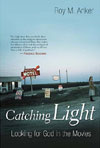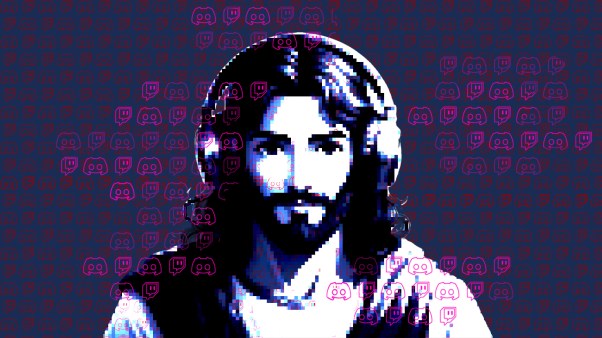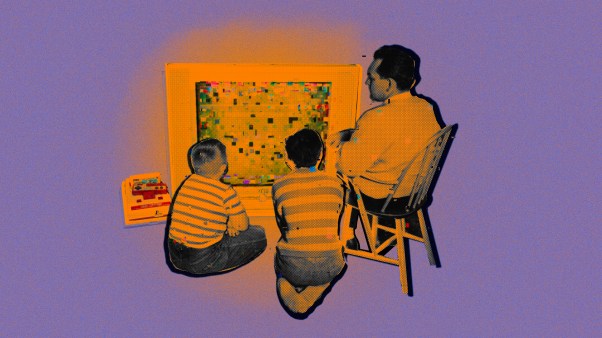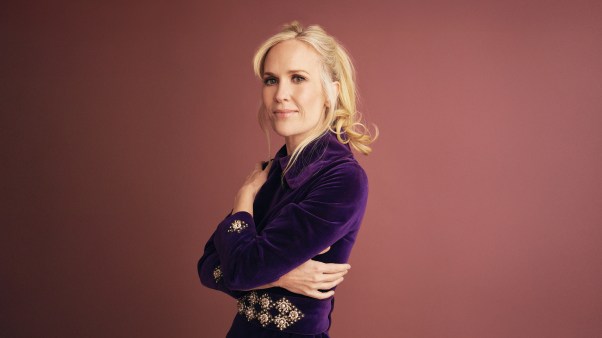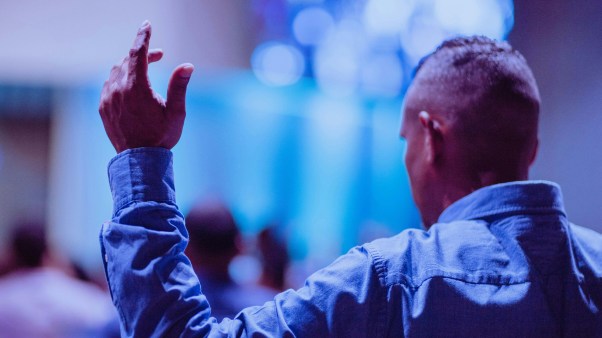Wednesday’s segment ended with Darth Vader saving his son Luke from the Evil Emperor, and in doing so, restoring himself to Jedi status—a transformation no one guessed was possible: “Through the son’s witness of love, the father is redeemed, and the father and son meet in reconciliation and true communion.” That’s where we pick up the story, with Luke huddled over his dying father …
This is aptly symbolized by Vader’s dying request that his son remove that stark black mask, itself a potent visual symbol, so he might at last see his son with “my own eyes” or, as 1 Corinthians 13 puts it in the rapturous image of reconciliation and intimacy, “face to face.” As the son was willing to die for his father, the father in his last gesture willingly dies for his son. When Luke tells his mortally wounded father that he will die if he removes the mask and that he must get Darth Vader from the Death Star in order to save him, the hideously maimed old man, whose appearance is an apt visual reflection of his inner distortion, replies simply to his son, “You already have.” Luke has given his father salvation and, as we soon see, redemption. In this expression of love, both father and son realize the good and holy identity for which they were made. Evil as manifested in the Empire and in Darth Vader has been defeated; goodness reigns.
Partly because the Star Wars saga is melodrama, and partly because human instinct tends to prematurely separate the sheep from the goats, the potential for the redemption of Darth Vader never crossed the well-set minds of most viewers. For some, the redemptive ending was not entirely plausible. The Time magazine reviewer, for example, thought it corny. But the very surprise it occasions effectively uncovers the bad manners of contemporary cynicism and hopelessness. That is admittedly a preachy point to make, but the effect of the ending of The Return of the Jedi, the unlikely return itself, pivots on the audience’s usual gullibility about the way the world usually works, which is badly. Sinners, whores, and late grape-pickers all the same, contemporary imaginative habits are constrained to see judgment and doom, to turn away from the possibility of renewal.
Vader’s redemption complete
The fullness of the redemption of Darth Vader, which is the final fruition of the motives and actions of the Force, is best seen in what happens in the last scenes of The Return of the Jedi. From the exploding Death Star and the Endor moon, where Leia and Han Solo await the return of Luke, the camera cuts abruptly to a gorgeous shot of the head of a burning torch against a black background. The camera moves with the torch as it ignites a funeral pyre where the body of Darth Vader lies, still attired in black helmet-mask and black cape. The camera cuts to Luke Skywalker, who holds the torch and watches the flames engulf the pyre and the body. Here light and fire burn in the darkness to consume darkness, an apt visual evocation of the first chapter of the Gospel of John, with its rhapsodic fugue on light and darkness.
The camera stares for a long time at the fire consuming the darkness of evil, this ancient Christian symbol for purification (and in the work of modern poet T. S. Eliot). The camera tilts upward to the darkening Endor sky where, with still more imagery of light in the darkness, fireworks explode in celebration of the victory over the Empire. For the film’s last scene the camera tilts down to take in the twilight Valley of the Ewoks, where small fires light many parties of celebration. At one of these we find the familiar crew of characters dancing and backslapping in celebration. Luke Skywalker arrives to hugs and congratulations from his sister and compatriots, including his old rival Han, who has finally come to understand that it is he, and not Luke, whom Leia wishes to marry.
Still mourning his dead father, Luke wanders off to view a consoling vision of two nearby shimmering figures, a ghostly Obi-Wan and Yoda, gentle and smiling; they are then joined by a third Jedi, someone not seen before in the film but also dressed in the monk’s robes of the Jedi. Slowly it dawns on viewers that this unfamiliar face resembles the maimed suffering face of Darth Vader; indeed, it is he, but he now appears healed and renewed in the person of the redeemed Jedi Anakin Skywalker. The malevolent Lord Darth Vader is dead. Evil and death have not conquered; the good man who Vader once was lives again—forever. He joins the others to smile on Luke, who will hereafter always have with him these guiding presences, emblems and agents of the abiding care of the Force, which is love itself. A spiritual brotherhood reigns over all, giving solace and hope, pointing the way for the future.
The New Creation
The central story in the Star Wars epic culminates in these sequences of redemption and reconciliation, completing and clarifying the thematic heart of Lucas’s trilogy. As Luke finds reconciliation and intimacy with his godforsaken father, the ragtag assembly of characters ends up forming a new family of mutuality that looks a lot like what the New Testament envisions as the constituency of the family of God. From the very start, the high purpose of the Republic draws together a host of strange and unlikely prospects into one huge cooperative crew that moves increasingly toward interdependence and caring.
In the first episode, for example, Obi-Wan is a mentor and father to Luke Skywalker, the orphan from podunk, as they go off together to rescue the endangered Princess Leia and—unbeknownst to and undreamt by childish Luke—to rescue the Republic and, with that, the very fate of the galaxy. For transport, Obi-Wan and Luke hire Han Solo, a smuggler with a price on his head in the underworld. A prototypical prodigal scalawag, a hard-bitten and self-interested loner, as his name reflects, Solo reluctantly comes to a new vision of life beyond self-interest. His tough-guy prowess demands that he rescue Luke and others from tight scrapes; yet he is overwhelmed when the same is done for him, when, in The Return of the Jedi, Luke and his compatriots risk life and limb to retrieve him from Jabba the Hutt’s pit of torture. The gang had earlier picked up a man of dubious morals, Lando Calrissian, buccaneer and black-marketer. So it goes, time after time.
Perhaps there is no greater surprise than the abundant help the group receives from the unlikeliest of all allies, the diminutive Ewoks, the ingenious teddy-bear race whose backwoods booby traps reduce the high-tech Empire troops to helplessness. The cute and furry little beasts, an unlikely source of any help, prove as game and vital in defeating the Empire as Han Solo and his machismo. Wookiees, droids, Ewoks, crooks, princesses, con men, orphans, and priests—all join up to smite the foul and unholy Empire. All this wild unexpected collaboration by natural antagonists is beautifully portrayed in the closing celebrations on Endor, where Ewoks and droids dance with humans and Wookiees. They have come to know one another as the compatriots they were made to be. More than that, brother now knows sister, and son now knows father. The sky explodes in gladness, as trust and harmony again pervade the world, making it a home for all.
Past and Future
The future of the Star Wars saga lies in its past. The original Star Wars, now officially entitled Episode IV: A New Hope, the first of the original trilogy to be filmed, showed how light comes out of darkness. The new trilogy—Episodes I-III—shows how darkness emerges from light, how people and societies come to lose harmony and hope; it is George Lucas’s attempt to explain how the knighthood of Jedis was dislodged and the old Republic fell into the “dark times” under the tyranny of the Empire. But he does not in the least diminish those religious elements so prominent in the first trilogy. In Episode I: The Phantom Menace, Lucas makes more obvious and heavier still the mythic freight at the heart of his adventure. We begin at the apprenticeship of a younger Ben Obi-Wan Kenobi (Ian McGregor), the old man who dies in the first Star Wars film. He becomes the mentor of the boy Anakin Skywalker, another obscure kid on the desert planet of Tatooine who is strong with spiritual potential, just as his son after him will be.
More portentous still is the possibility that the boy Anakin is of mysterious virgin birth and might be one to fulfill ancient prophecies about the coming of a potent savior figure. Indeed, the ten-year-old shows remarkable intelligence and physical prowess. Still, the Jedi Council, headed by a relatively youthful Yoda, is uncertain of the wisdom of accepting the boy as a Jedi novice-apprentice, given his age (he’s too old even at age ten), the murkiness of his background, and his personal volatility. That is where Episode I ends, a clear set-up piece for the conflict that follows in Episode II: The Attack of the Clones (2002). In that prequel Lucas further explores the personal sources that make Anakin Skywalker, now a young man rashly in love with the Princess, susceptible to the vile Emperor and the dark side of the Force. And now Episode III: Revenge of the Sith dramatizes how Anakin finally succumbs to the blandishments of hate that comprise the dark side.
In attempting to create an enticing prequel for a movie myth that just about everybody knows and very many downright love, Lucas set for himself a great challenge. Those first films were so good—and now are so legendary—that Lucas has had a difficult time measuring up, especially to the expectations of Star Wars junkies waiting with bated breath to dissect every bit of the endless pre-release gossip and hype. To its credit, The Phantom Menace tells its story pretty efficiently, dispensing with the frequent lengthy diversions that diluted the dramatic impact of the central conflict in The Return of the Jedi. Yet, while there is much to appreciate in this first of a new trilogy for the twenty-first century, especially its visual splendor, it has by and large fallen rather flat because it lacks the steady humor and visual wit of the earlier films. The primary figure for comedy, a new creature named Jar Jar Binks, is difficult to understand and, compared to the Wookiees and droids, painfully unfunny. Nor is the film as effective in establishing another ragtag “family” of interdependent relationships, which provided much of the warmth and emotional magnetism of the first trilogy; we end up caring less about these creatures and their collective fate than we did about those in the first Star Wars films.
Some of that lack no doubt comes from Lucas’s strenuous effort to explain the origins of later characters, and so far neither they nor the crises that will bring them together have reached full bloom. The first Star Wars film started in medias res, the middle of a pivotal crisis, while the Phantom prequel is busy constructing the pieces that will lead to that decisive moment. The crisis it constructs—again, the peril of another young female royal—is rather tame, visually static, and narratively arcane. In a way, having experienced the pleasures of the original three films, we know too much for Lucas’s own good. Overall, though, The Phantom Menace is a pretty good adventure, a real genuine kid movie for all ages, full of visual magic, moral contest, and anticipation—for the next Star Wars movie. That next one, The Attack of the Clones, just about killed interest in the series, due to poor casting, even poorer direction, and pedestrian camera work. It is clear that, while Lucas is a great myth-maker and story-shaper, he sadly lacks facility as a director (Irwin Kershner directed Empire, and Richard Marquand directed Jedi).
Mostly, though, we already know what we need to about the central mystery of the Star Wars saga, both present and past. At its core is a complex and fetching portrait of what Lucas in his fantasy world labels the Force, by which he means, as he has said directly in interviews, God. With studied restraint, he does not go so far as to specify which God he is depicting; but his prime purpose, he says, is to show his audiences what it is like to believe in God (Time, April 26, 1999).
More than ever, as The Phantom Menace makes clear, Lucas seems intent on making that goal overt so that audiences cannot mistake his point. Indeed, it is easy to see Lucas trying to construct his own sci-fi versions of J. R. R. Tolkien’s The Lord of the Rings or C. S. Lewis’s protracted fantasy in The Chronicles of Narnia. Some conservative religious people have fretted extensively about supposed “New Age” influences. But it is best to take the series as Lucas intends it: an exploration of what it is like to live amid invisible realities that shape individual lives and that care, radically, for the fate of this whole world.
Roy M. Anker is professor of English at Calvin College in Grand Rapids, Michigan. He is also the editor of Dancing in the Dark: Youth, Popular Culture, and the Electronic Media, and author of the two-volume Self-Help and Popular Religion in American Culture.
Reprinted from Catching Light: Looking for God in the Movies (Eerdmans). Used by permission. To purchase a copy of Catching Light, click here.
Copyright © 2005 Christianity Today. Click for reprint information.

